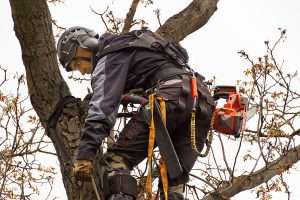Skilled Tree Saving Services for Storm-Damaged Properties
Weather can be wild in any season in this region. From heavy snow and ice in the winter to wild winds and heavy rain in the summer, a bad storm can do real damage. Even a tree that has been seemingly healthy and sturdy for years can be battered by a bad storm. Many homeowners aren’t sure what to do when looking at the aftermath of a storm and what it’s done to the trees on their property. Likely, you know simply by looking that your tree is damaged, but you may not be sure you know what to do next. Damaged trees can pose a safety risk, so it’s always wise to prioritize safety by calling professionals to evaluate the situation and help preserve your trees.

Professionals Start by Assessing the Damage
As a homeowner, you can see certain kinds of tree damage. If a tree has lost branches, has damage to the limbs, or split down the trunk, it will be evident to anyone that the tree needs help. However, other damage indicators may not be as obvious, and storms often expose that hidden damage. Fungal growth, soft spots, and cavities can be exposed after a storm, and a certified tree specialist will know what to look for and how to treat those underlying issues. A tree specialist will also focus most of their assessment on the tree’s base. Visible lifting roots will compromise the stability and integrity of the tree, but there can be other signs as well. The tree may be leaning, or the soil at the base may be heaving, indicating it was partially uprooted. If this is caught early, a tree care specialist can remedy the situation, saving your tree.
Storm-Damaged Trees Need TLC
If you don’t want to lose the tree, you need to immediately get some TLC for your damaged tree. There are steps that tree professionals can take that can save your tree.
- Splits
If the tree trunk has split, it may look bad, but some steps can be taken. If the split is minor, straps or cables can bind the trunk together in the proper alignment, which, if done early enough, can allow the tree to heal. If exposed, a split trunk can decay quickly, so prompt action is essential.
- Crown Damage
The crown of the tree is important, as the crown is what catches the rays from the sun and allows the tree to manufacture the sugars that keep the tree alive and healthy. Topping a damaged tree (removing the crown entirely) damages the tree’s health, as it will result in weak regrowth. Restoration pruning by an experienced and knowledgeable tree professional is a much better option.
- Branch Damage
Clean cuts are better for healing. Ragged separations, made by the storm itself or someone inexperienced, can make the tree more prone to disease or infestation. Clean cuts by professional-grade tools can remove damaged branches and promote healing.
If a Tree Needs to Come Down, Protect the Rest of Your Property
A quality tree service will always see if it’s possible to save the tree before recommending removal. Even a split tree can be saved depending on its health and the severity of the split. Be wary of any tree service trolling your neighborhood after a storm, telling you that a tree must come down immediately, and trying to get you to agree on the spot. However, that doesn’t mean you should take a “wait and see” approach if you notice tree damage. A damaged tree can be a serious safety hazard, and a damaged tree may cause harm to other trees on your property if it falls on its own. A quality tree service will always try to save the tree first. When there are trees that can’t be saved after a storm, a tree professional will take the time to assess the situation and make the best recommendation to keep you, your home, and your property safe. If the damage is severe enough, having a trusted tree professional remove the tree can prevent damage to the rest of your landscaping, as a tree that is damaged enough to warrant removal is a serious safety and liability risk.
Always Trust the Professionals to Handle Your Property After a Storm
You may pride yourself on your DIY skills around your home and property, but remediating tree damage should always be left to professionals with the tools and knowledge to handle it safely. Storm damage to a tree doesn’t necessarily mean the tree has to come down, but it does mean that you need to have professionals come out to assess and remediate the damage as soon as it’s safe. A damaged tree can be dangerous, and safety needs to be your top priority. Once you’ve called in the professionals to do their assessment, they will likely be able to save your tree and prevent further damage.
While you should be wary of storm chasers, you can’t wait long after a storm has caused damage to your trees to get the professionals out for assessment, remediation, or removal. A damaged tree is dangerous and poses a significant safety and liability risk. If you ignore the damage and the tree or its branches come down on their own, you could be held responsible for any damage to your property or neighboring properties. Severe weather is unpredictable, so it’s essential to be prepared to call in professionals to assess the damage and help protect your treeline.
If you’re dealing with storm-damaged trees and want to ensure the safety of your property and the health of your trees, trust the professionals at TREE SAFE. Their certified professionals can assess the damage, offer practical solutions, and help preserve or safely remove trees as needed. Don’t wait—contact TREE SAFE today for more information.